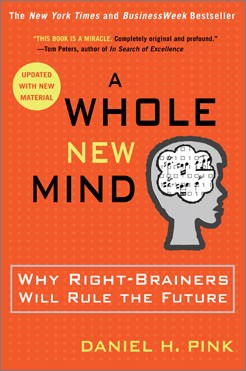by Daniel Pink., New York: Riverhead Books, 2005. 234 pages.
Reviewed by Diane Byington, Ph.D.
Daniel Pink opens our minds and shows us new possibilities in this entertaining book about how the right brain can contribute in a world that has long been devoted to left brain thinking. He begins by reviewing how the two halves of the brain work: the left hemisphere is sequential, analytical, verbal, and detail-oriented, while the right hemisphere processes information simultaneously, specializes in context, understands metaphor and nonverbal cues, and synthesizes the big picture. Pink’s thesis is that right-brain directed thinking, so often disdained and dismissed, will increasingly determine who soars and who stumbles.
He explains the reasons behind the shift from left to right brain dominance: abundance, Asia, and automation. In our abundance, we acknowledge that our left brains have made us rich. We can buy just about anything we want at a minimal price. This puts a premium on the aesthetic. For business, it’s no longer enough to create a product that’s reasonably priced and adequately functional. Now it must be beautiful, unique, and meaningful to be competitive.
We have outsourced many of our “knowledge worker” jobs to Asia, especially those jobs in the computer, software, and information technology industry. Remaining workers are going to have to focus on forging relationships, tackling novel challenges, and synthesizing the big picture, while the routine work is carried out by machines or workers in Asia.
Automation is adding to the shift as computers increasingly do the work that people used to do. Any job that depends on routines – that can be reduced to a set of rules, or broken down into a set of repeatable steps – is at risk, either to cheaper labor in Asia or to a computer.
But Pink doesn’t despair about these changes. Instead, he invites us to enter the Conceptual Age, where right brain directed thinking will prevail. He describes how society has moved since the 18th century through the Agriculture Age, the Industrial Age, the Information Age, and is now entering the Conceptual Age, which will reward creators and empathizers. To survive in this age, individuals and organizations must examine what they’re doing to earn a living and ask themselves three questions: 1. Can someone overseas do it cheaper? 2. Can a computer do it faster? 3. Is what I’m offering in demand in an age of abundance? Mere survival today depends on being able to do something that overseas knowledge workers can’t do cheaper, that powerful computers can’t do faster, and that satisfies one of the nonmaterial, transcendent desires of an abundant age. We are entering a time when the MFA (Master of Fine Arts) will replace the MBA as the most important preparation for a career in business, when EQ (emotional intelligence) will be more valuable than IQ, and when business will focus on providing meaning and transcendence to its employees and customers.
As the shift to the Conceptual Age deepens, Pink asserts, six skill sets will be much in demand:
- Not just function but also DESIGN. It’s no longer sufficient to create a product, service, or experience that’s merely functional. Today it’s economically crucial and personally rewarding to create something that is also beautiful, whimsical, or emotionally engaging.
- Not just argument but also STORY. When our lives are brimming with information and data, it’s not enough to marshal an effective argument. The essence of persuasion, communication, and self-understanding has become the ability to fashion a compelling narrative.
- Not just focus but also SYMPHONY. Specialization and focus belong to the Information Age. The Conceptual Age rewards synthesis – seeing the big picture, crossing boundaries, and being able to combine disparate pieces into an arresting new whole.
- Not just logic but also EMPATHY. What will distinguish those who thrive will be their ability to understand what makes their fellow humans tick, to forge relationships, and to care for others.
- Not just seriousness but also PLAY. Too much sobriety can be bad for your career and worse for your general well-being. In the Conceptual Age, we will all need to play more.
- Not just accumulation but also MEANING. In a world of material abundance, we are liberated to pursue more significant desires: purpose, transcendence, and spiritual fulfillment.
The second half of the book includes a chapter on each of these skills, which makes the case for its value and ends with several pages of suggestions to sharpen your skills. These chapters are fun, as he includes his own experiences in the narrative. For example, readers see his progress in taking a “Drawing on the Right Side of the Brain” workshop. At the beginning, his self-portrait is a stick drawing. By the end of the five-day workshop, he is able to draw a reasonable likeness of his face, with shadings and facial expression.
He includes quite an array of footnotes and citations to back up his assertions. They are useful, of course, but not the main value of the book. What is most important to me is his optimistic view of the world, his creative synthesis of a variety of trends, and his willingness to put his ideas out there. He is truly a thought leader, whether or not he ultimately turns out to be correct. That probably explains why this book has been on the bestseller list for years.
— Diane Byington is a writer and coach who consults with The Booth Company.

